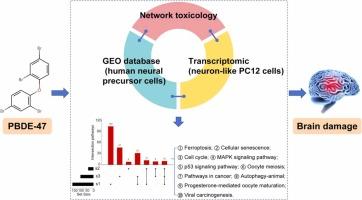网络毒理学和转录组学的整合揭示了2,2 ',4,4 ' -四溴联苯醚的新的神经毒性机制
IF 11.3
1区 环境科学与生态学
Q1 ENGINEERING, ENVIRONMENTAL
引用次数: 0
摘要
溴化阻燃剂2,2 ',4,4 ' -四溴联苯醚(PBDE-47)被认为是一种发育性神经毒物,但其潜在机制尚不清楚。本研究将网络毒理学与转录组学相结合,以人类神经前体细胞(hNPCs)和神经元样PC12细胞为研究对象,探讨其神经毒性机制。网络毒理学显示,PBDE-47比更重的PBDE同系物更有效地穿过血脑屏障,并与159个生物通路的破坏有关,包括胞质dna传感通路、铁凋亡、细胞衰老和趋化因子信号通路。此外,对暴露于PBDE-47的hnpc和PC12细胞的转录组学分析发现,hnpc细胞中有855个和702个基因上调和下调,PC12细胞中分别有2844个和2711个基因下调。这些差异表达的基因主要涉及神经活性配体-受体相互作用、核细胞质运输、铁下垂、p53信号传导和细胞周期调节等关键过程。综合研究结果确定了PBDE-47神经毒性的新机制,如神经炎症和细胞衰老,以及铁下垂、细胞凋亡和细胞周期阻滞等已建立的机制。总的来说,这些发现为PBDE-47神经毒性的机制提供了重要的见解,突出了网络毒理学和转录组学的整合作为探索毒物作用模式的新研究方法。本文章由计算机程序翻译,如有差异,请以英文原文为准。

Integration of network toxicology and transcriptomics reveals the novel neurotoxic mechanisms of 2, 2′, 4, 4′-tetrabromodiphenyl ether
The brominated flame retardant 2, 2′, 4, 4′-tetrabromodiphenyl ether (PBDE-47) is known as a developmental neurotoxicant, yet the underlying mechanisms remain unclear. This study aims to explore its neurotoxic mechanisms by integrating network toxicology with transcriptomics based on human neural precursor cells (hNPCs) and neuron-like PC12 cells. Network toxicology revealed that PBDE-47 crosses the blood-brain barrier more effectively than heavier PBDE congeners, and is associated with disruptions in 159 biological pathways, including cytosolic DNA-sensing pathway, ferroptosis, cellular senescence, and chemokine signaling pathway. Additionally, transcriptomic analyses of hNPCs and PC12 cells exposed to PBDE-47 uncovered substantial gene expression changes, with 855 and 702 genes up- and down-regulated in hNPCs, and 2844 and 2711 genes in PC12 cells, respectively. These differentially expressed genes were primarily implicated in crucial processes like neuroactive ligand-receptor interaction, nucleocytoplasmic transport, ferroptosis, p53 signaling, and cell cycle regulation. Integration of the results identified novel mechanisms of PBDE-47 neurotoxicity, such as neuroinflammation and cellular senescence, alongside established mechanisms like ferroptosis, apoptosis and cell cycle arrest. Overall, these findings provide critical insights into the mechanisms of PBDE-47 neurotoxicity, highlighting the integration of network toxicology and transcriptomics as a novel study approach to explore the modes of action of toxicants.
求助全文
通过发布文献求助,成功后即可免费获取论文全文。
去求助
来源期刊

Journal of Hazardous Materials
工程技术-工程:环境
CiteScore
25.40
自引率
5.90%
发文量
3059
审稿时长
58 days
期刊介绍:
The Journal of Hazardous Materials serves as a global platform for promoting cutting-edge research in the field of Environmental Science and Engineering. Our publication features a wide range of articles, including full-length research papers, review articles, and perspectives, with the aim of enhancing our understanding of the dangers and risks associated with various materials concerning public health and the environment. It is important to note that the term "environmental contaminants" refers specifically to substances that pose hazardous effects through contamination, while excluding those that do not have such impacts on the environment or human health. Moreover, we emphasize the distinction between wastes and hazardous materials in order to provide further clarity on the scope of the journal. We have a keen interest in exploring specific compounds and microbial agents that have adverse effects on the environment.
 求助内容:
求助内容: 应助结果提醒方式:
应助结果提醒方式:


